Make Your Bed
In the beginning, manufacturing mattresses was not a business. It was a home activity, a periodic chore, literally “making your bed.” Find something – anything – to put on the ground to cushion you while sleeping. It could be supple small, green branches covered with straw and leaves. Put down an animal hide or a mat woven from strips of bark. Your coat is now your blanket.
It’s in the Bag
Early in history people began filling bags with soft materials and sewing them shut – cushions to sit on, pillows to lay your head on. In ancient Persia or Babylon or Egypt, cushions were made large enough to lie on. These filled sleeping mats were called “materas” – the source of our word “mattress.” By the Middle Ages, they were commonly used by the Arabs.
Merchants and invaders (Crusaders) found people using these early mattresses. Migrants took their materas with them. The idea was copied, and it spread.
The Business of Sleep
Sometime, somewhere, someone made a mattress for someone else and was paid for it. Then making mattresses became a business. It was all local. Rarely were mattresses items for inter-city commerce unless they were exceptional luxury items worthy of trade.
Mattresses were filled with any kind of cushioning material. Common fillers were straw, feathers, down, wool, horsehair, sawdust, leaves, and rags. When cotton was introduced from India and the Americas, that was used. In time, it became the most common mattress ingredient, especially with the advent of the Industrial Revolution.
The Beginning of Modern Mattresses
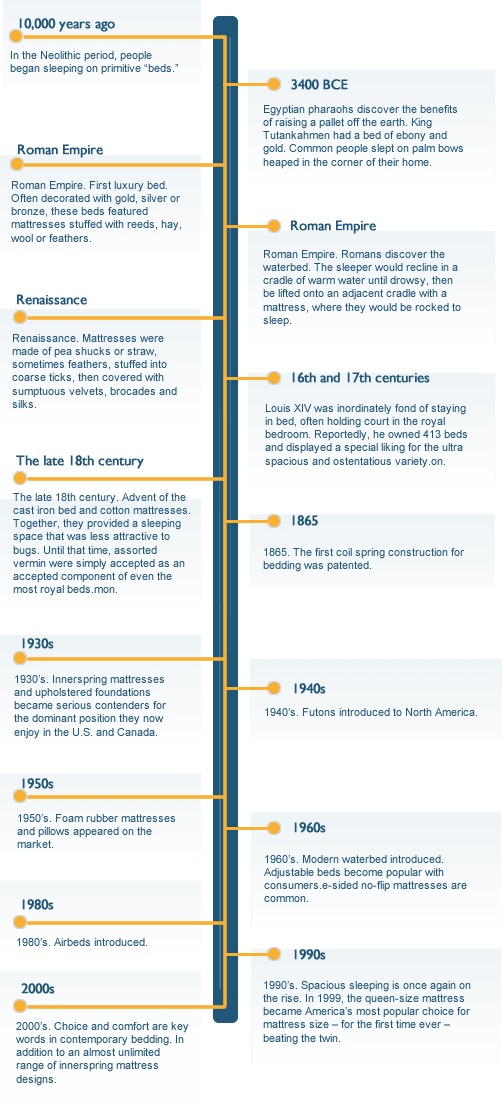
The Industrial Revolution
The Industrial Revolution influenced the making of mattresses. The cotton gin, spinning mills, and textile mills made cotton and cloth less expensive and more readily available. Sewing machines and gas and electric lighting made production more efficient. Better roads and motor vehicles enabled manufacturers to serve a wider area, even locally.
By the time of the Industrial Revolution, mattresses were put on raised beds, a practice common in Colonial America. Though raised beds were first used in ancient times, they were only used by the wealthy and nobility until the 1700s, and then were more common in America than in Europe.
Raised beds were rectangular, so mattresses generally assumed the boxy shape we are familiar with today. This configuration with its series of straight seams was well-suited to factory production. Several mattress companies today are or were also furniture manufacturers, making both the bed and the mattress to put on it. And many furniture retailers also sell mattresses.
The making of mattresses benefited from industrialization. It made them less expensive. And the wages of industrial workers increased the demand. Also increasing demand was the increase in local populations, with workers moving in from rural areas and immigrants coming to work in the cities. Even so, mattress manufacturing was mostly a local industry. All of the mattress companies today that began in the 1800s, even those that operate globally today, were first local companies. For a mattress manufacturer to begin life as a national seller is a relatively recent phenomenon.
Cotton Beds
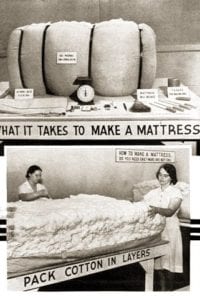 For most of the Nineteenth Century cotton mattresses were the most common type. The shell of the mattress was a heavy-duty cotton weave. In it were layers of cotton batting and cotton felt. The felt was smoother and kept its shape better, but the batting tended to get lumpy. Mark Strobel of Strobel Technologies Company explains the difference this way:
For most of the Nineteenth Century cotton mattresses were the most common type. The shell of the mattress was a heavy-duty cotton weave. In it were layers of cotton batting and cotton felt. The felt was smoother and kept its shape better, but the batting tended to get lumpy. Mark Strobel of Strobel Technologies Company explains the difference this way:
Cotton mattresses differentiate themselves in price points by using combinations of raw cotton and cotton felt. Cotton felt is cotton that is run through a garnet machine which combs the cotton into a fine and fully layer. Medium price mattresses had a layer of cotton felt on the outside portions with raw cotton stuffed in the center. Higher priced mattresses were all cotton felt.
After layering the cotton and sewing the ticking shut, the cotton mattress was tufted – long heavy threads pulled through the mattress from top to bottom and tied off, holding the layers in place. This prevented shifting and clumping, helping the mattress to hold its shape.
Springs for Sleeping
The invention of coil spring support for seats in the middle of the 1800s led to the invention of mattress springs. The first innersprings for mattresses were Bonnell coils – hourglass coils tied in rows with helical wires. On either side of the innerspring, a felt insulator kept the cushioning (cotton or wool batting) from intruding into the coils.
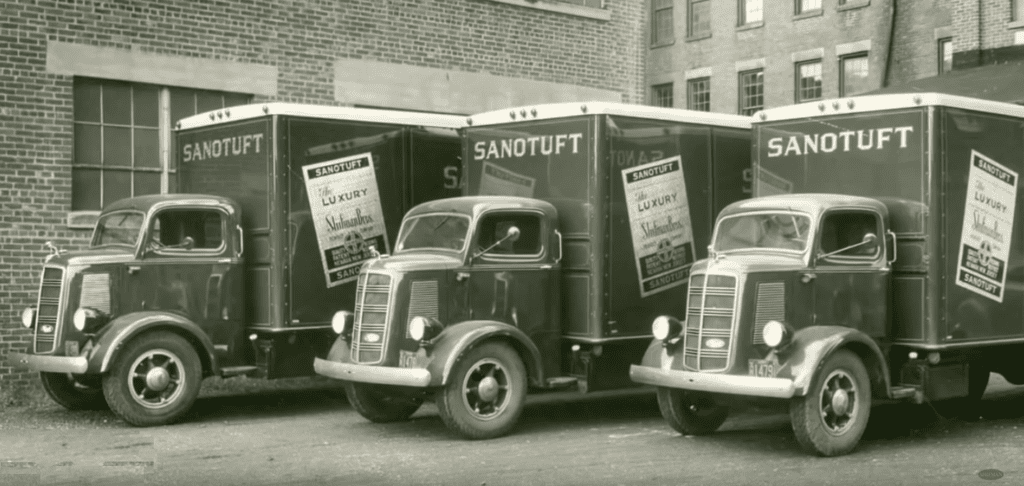
The innerspring mattress was a child of the Industrial Revolution. It also played a role in moving the mattress business beyond the local level.
Wire was drawn and coiled into springs by machines. Machines placed the coils in rows and threaded the helical wire along the row. Though the innerspring mattress offered support superior to that of the cotton mattress, it did not gain real popularity until World War I and World War II.
Mattresses and War
When a country goes to war, it needs soldiers and sailors. And soldiers and sailors need places to sleep and beds to sleep on.
When the United States entered the First World War, the War Department needed to house recruits during training and in staging areas for battle. This meant they needed a lot of mattresses, so they contracted with local mattress manufacturers to make mattress for them.
The mattress makers increased their production capacity to meet the demand. After the war, they had excess capacity, so they reached for a broader market. Local became regional. Motor trucks were now available to serve a wider delivery area. One development in this time was the first foam rubber (latex) mattress in 1931, which had future significance.
The same thing happened on a much larger scale for World War II. With so many mattresses going to the military, the Federal government even encouraged citizens to make their own cotton mattresses at home.
After the war, manufacturers again found themselves with excess capacity. By this time, regional and local mattress manufacturers were merging or partnering with others to form national brands, a trend that began between the wars. A major part of this was licensing local mattress manufacturers to make national brands to sell in their local and regional markets. Two examples of this were Sealy and Spring Air. As such, they could take advantage of national advertising in major publications and on radio networks. They could also take advantage of the post-war demand for items which had been in short supply during the war, including mattresses.
The overwhelming majority of mattresses sold in the post-war mattresses were innerspring mattresses. The support was more consistent than the better-known of available non-spring mattresses. Most of these were cotton mattresses with more batting than felt. Some had not batting, but bulk cotton, which had to be beat into place during manufacturing, and required frequent adjustment by the users to correct lumpiness. Other non-coil mattresses had all-wool, all feathers & down, or combinations of cotton & wool with horsehair or other fibers.
Challenges to Innersprings
The innerspring was the king of mattresses, but challengers arose.
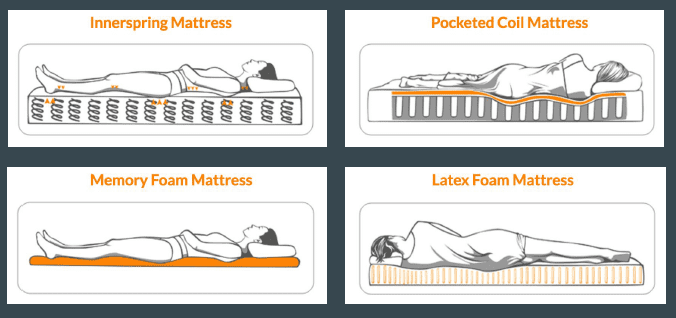
Latex
The first was foam rubber, now known as latex. One producer of foam rubber mattresses was Firestone, the tire maker, whose Foamex division (now FXI) advertised the Form-Fitted Mattress in a magazine ad in 1952. Unlike fillings of loose fiber and fiber batting, a slab of foam rubber could hold its shape – the foam simply compressed and decompressed without shifting its position in the mattress.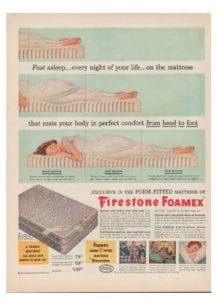
Polyurethane Foam
Then came flexible polyurethane foam (FPF). At first, it was too stiff to use in mattresses. Then, in 1956, the use of blowing agents made it both more flexible and less expensive. By the 1980s, sales of FPF mattresses had overtaken foam rubber mattresses, primarily because they were less expensive.
Waterbeds
The waterbed boom began in 1971. By 1987, more than 20% of mattresses sold were waterbeds. Most of these were hard-side waterbeds – a hard-side is a vinyl bladder filled with water in a wooden frame. Pocket coils, invented in 1900, provided pressure relief, and were popularized in the Simmons Beautyrest line. Waterbeds offered a different manner of pressure relief through fluid displacement. As a person lies on a waterbed, the larger parts push into the water, and the water pushes up on the smaller parts for even support. It was this kind of support that made the waterbed popular.
Airbeds
The next challenger was the airbed. For more than a generation inflatable air mattresses had been used for camping or as temporary beds for guests – especially children. In the 1980s, Comfortaire introduced adjustable air beds for the bedroom. These fit on regular beds, taking the place of conventional mattresses. These began to cut into waterbed sales. Three advantages of airbeds accounted for this – adjustability, convenience, and reduced risk:
- The pressure (hardness) of a waterbed cannot be adjusted by someone already in bed, but the air pressure of an adjustable airbed can.
- Filled waterbeds are extremely heavy and impossible to move, but filling an airbed does not make it any heavier as far as lifting and moving are concerned.
- A leak in a waterbed can cause damage to the room unless contained, but all a leak will do to an airbed is to make it lose pressure.
Memory Foam
In the 1960s, a NASA contractor was modifying FPF to make self-conforming material to cushion astronauts during a launch. The result was temper foam, a heat-sensitive material. In the 1980s, NASA released this material for commercial development, and the result was memory foam, which quickly became popular for mattresses, first in Sweden, then in the United States.
Since the introduction of memory foam mattresses, they have cut into the market share of innerspring mattresses, waterbeds, and airbeds. After a while, the intrusion of memory foam mattresses slowed down.
One reason was price points. Memory foam mattresses are generally more expensive than innerspring mattresses, and the market was finally reaching the equilibrium point between the two mattress types.
Another reason was heat. Memory foam is heat-sensitive, so it accumulates heat. For many sleepers, memory foam was too warm to sleep comfortably.
Another reason was the sinking-in feeling of memory foam. This was exacerbated by the very thing that made memory foam popular – its memory. Users found it hard to change position on memory foam, and hard to get out of bed. It was also slow to respond when the user got into bed – it had to first warm up. The default Tempur-Pedic memory foam was 5-lbs/ft3. This memory foam was slow to adjust to the change in position.
Dr. Swartzburg solved this in the Tri-Pedic mattress by splitting the memory foam layer into two, with a lighter 4-lbs/ft3 layer on top. The 4-lb. memory foam is less heat-sensitive and more pressure-sensitive, so it responds more quickly, both when the sleeper gets into bed and when they move. When Tempur-Pedic adopted this concept, their sales rose again.
Resurgence of Latex
Ironically, the surge of memory foam mattresses contributed to increased sales for latex mattresses. There is more than one reason for this.
- Thanks to memory foam, many sleepers became used to sleeping on something other than an innerspring mattress. When they look for a new mattress, other specialty sleep (non-coil) mattresses get their attention.
- Many sleepers want or need more resilience. Latex is more resilient than memory foam.
- The use of Talalay latex, which is more breathable and can be made into a wider range of firmnesses than Dunlop latex foam.
- More consumers are looking for more natural products, including mattresses. Natural latex is made from a renewable natural source, the rubber tree, and many manufacturers are now making mattresses with 100% natural latex. In answer to this concern, manufacturers of polyurethane and memory foam are seeking to perfect foams made from plant-oils rather than petroleum.
The Global Market
Many mattress manufacturers are now global. Tempur-Pedic was established in the United States by the Swedish firm Fagerdala to sell memory foam mattresses in North America. Several luxury mattress firms in America (ES Kluft and Aireloom), Britain (Vi-Spring) and other countries are now under one corporate roof: Spain’s Flex Group.
Among U.S. based mattress companies which began as local manufacturers and became global firms are Eastman House Bedding, which started in 1866 in Burlington, Iowa, and Kingsdown, started in Mebane, North Carolina in 1904. Added to this are several European and Australian brands sold in the United States and Canada.
eCommerce
The latest major development in the mattress business is ecommerce. Online sales have been increasing at the expense of physical stores. This is resulting in a decline of shopping malls and national retail chains (ironically, as big box stores decline, local stores are making a comeback). This now includes mattresses.
For a long time, mattress shoppers went to furniture stores, mattress stores and department stores to see the mattresses for themselves, feel them, and test them. With too many confusing choices, high pressure sales and high prices, coupled with disappointment in the final product, they were open to options.
Manufacturers and retailers had already been listing their mattresses online. This was a form of advertising and a preview of what the consumer would find in the store. If the mattress was ordered online and delivered to the customer, delivery was expensive because of the bulk and weight of the mattress.
In the 1980s, Magniflex in Italy developed a process for compressing, rolling, and packaging their memory foam mattresses for less expensive shipping. The same concept was adopted by a U.S. company, BedInABox. Other companies, such as Selectabed, followed suit.
What really sparked the trend was the introduction of the Casper Mattress. Casper Sleep, led by mattress veteran Phil Krim, simplified the process of shopping for a mattress with one model with a firmness to fit most sleepers sold only online from their website and on online marketing giant Amazon. Several other mattress startups followed, with more than a score of online-only mattress brands. Not all of these are from startup companies – established manufacturers are now making their own contributions to the online mattress market.
The Wrinkle
A wrinkle has developed in the one-model-only-online format of boxed beds. First, a number of the startup companies have begun offering firmness options or additional models. For instance, Casper Sleep now has three models. Second, some of these direct-to-customer startups, such as Tuft & Needle and Casper Sleep, have several showrooms. Additionally, these newcomers have become attractive merger targets. Yogabed is now part of white noise machine maker Marpac, and Tuft & Needle is merging with Serta Simmons Bedding.
From Here on
Beginning with making your own bed with whatever was at hand, then local and national manufacturers of increasingly sophisticated mattresses, we have moved to national and global bedding markets. Now we can stay at home, select our new mattress from any of several types and brands, and have them delivered right to our door in a box we can carry or drag to the bedroom to open and expand. Wherever we go from here, it will not be the same way our ancestors – or even our parents – put a bed in the house.


